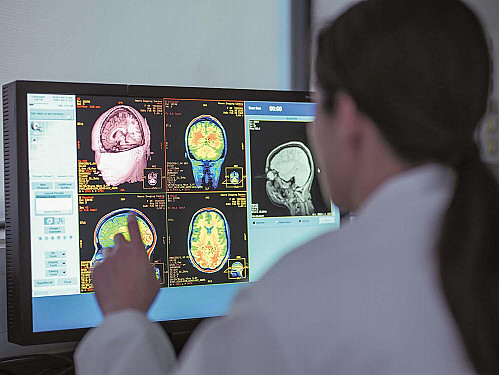Infectious mononucleosis
- Reviewed by Robert H. Shmerling, MD, Senior Faculty Editor, Harvard Health Publishing; Editorial Advisory Board Member, Harvard Health Publishing
What is mononucleosis?
Infectious mononucleosis is an illness caused by a viral infection. It is commonly called mononucleosis, or "mono." Mononucleosis is most often caused by the Epstein-Barr virus, though it can be caused by other viruses.
Mononucleosis has been nicknamed the "kissing disease." This is because Epstein-Barr virus commonly is transmitted during kissing. However, sneezes and coughs also can transmit the virus.
Once a person is infected with Epstein-Barr virus, the virus remains in that person's body for the rest of his life. Mononucleosis typically occurs when a person first is infected with Epstein-Barr virus. But infection with Epstein-Barr virus does not always cause mononucleosis. It often causes only a mild illness or no illness at all.
Symptoms of mononucleosis
The first symptoms of mononucleosis typically include:
- fever
- headaches
- muscle aches
- unusual fatigue, such as the need for 12 to 16 hours of sleep daily.
These symptoms are followed very shortly by:
- sore throat
- enlarged lymph nodes
- chills
- joint aches
- loss of appetite and slight weight loss
- nausea and vomiting (occasionally)
- a red rash, usually on the chest (this is more likely if the person has recently taken the antibiotics ampicillin or amoxicillin)
- abdominal pain.
Rare symptoms include:
- jaundice (yellow skin and eyes)
- difficulty breathing
- palpitations.
In rare cases, an enlarged spleen can rupture. The spleen is a small organ near the stomach. Untreated, a ruptured spleen can cause life-threatening internal bleeding.
Diagnosing mononucleosis
Your doctor will ask you about your medical history and current symptoms. He or she will want to know about recent exposure to anyone with mononucleosis or mono-like symptoms.
During a physical exam, your doctor will look for signs of mononucleosis. These include:
- fever
- a reddened throat with enlarged tonsils
- swollen lymph nodes in the neck and elsewhere
- an enlarged spleen
- a red rash, usually on the chest.
Your doctor also will request blood tests to help make the diagnosis. The results of these blood tests may not be abnormal until the person has been ill for a week.
Two types of blood tests help to make the diagnosis:
- Differential white blood cell count. This test measures levels of different types of white blood cells. In the first few weeks of mononucleosis, the number of lymphocytes (a type of white blood cell) tends to be quite high. There also are large numbers of lymphocytes that look unusual, called atypical lymphocytes.
- Antibody tests. Mononucleosis often leads to the production of a type of antibody called heterophile antibody. Heterophile tests measure levels of heterophile antibody. One of the most commonly used heterophile tests is the Monospot test. Other common tests detect antibodies to Epstein-Barr virus.
Expected duration of mononucleosis
Symptoms usually are most intense during the first two to four weeks of the illness. But some symptoms, especially fatigue, can last for several months or longer.
Preventing mononucleosis
This disease is most contagious during its acute stage, when the affected person still has a fever.
Someone with mononucleosis does not need to be kept isolated from others, but avoiding close contact with others can help prevent spread. Common recommendations for people with mono include not kissing others while feeling ill, washing hands frequently, and avoiding coughing or sneezing near others.
Some authorities also advise avoiding sharing food, drinks, or eating utensils during the first few weeks of the illness.
Treating mononucleosis
There is no medical cure for mononucleosis. It usually goes away on its own.
Most treatment focuses on making the person more comfortable. Recovery usually calls for getting plenty of rest and fluids and treating symptoms.
Cold drinks, frozen desserts, and gargling with salt water can help to relieve minor sore throat pain.
Ibuprofen (Advil, Motrin) or acetaminophen (Tylenol) can be taken to fight fever and body aches.
Prednisone can shrink tonsils when they have become so swollen that it is hard to breathe.
It is important to protect the spleen from rupture. Avoid strenuous activities, especially contact sports, for at least four weeks, and until your doctor finds that your spleen is no longer enlarged.
When to call a professional
Call your doctor if you develop the symptoms of mononucleosis.
If you have been diagnosed with mononucleosis, contact your doctor immediately if:
- your breathing becomes difficult or noisy
- you experience significant pain in your abdomen
- your symptoms seem to be getting worse after one to two weeks.
Prognosis
Most patients with mononucleosis recover completely. Some people with the illness develop strep throat. This is a bacterial infection that needs to be treated with antibiotics.
Additional info
Centers for Disease Control and Prevention (CDC)
https://www.cdc.gov/
About the Reviewer

Robert H. Shmerling, MD, Senior Faculty Editor, Harvard Health Publishing; Editorial Advisory Board Member, Harvard Health Publishing
Disclaimer:
As a service to our readers, Harvard Health Publishing provides access to our library of archived content. Please note the date of last review or update on all articles.
No content on this site, regardless of date, should ever be used as a substitute for direct medical advice from your doctor or other qualified clinician.















